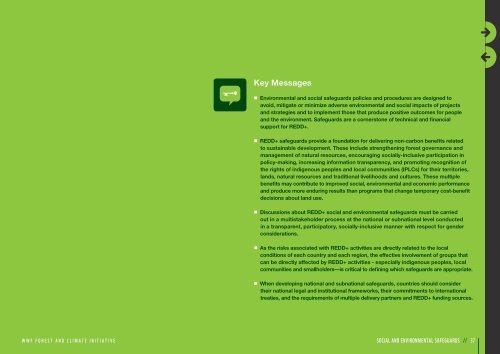WWF Guide to Building REDD+ Strategies
WWF Guide to Building REDD+ Strategies
WWF Guide to Building REDD+ Strategies
Create successful ePaper yourself
Turn your PDF publications into a flip-book with our unique Google optimized e-Paper software.
Key Messages<br />
n Environmental and social safeguards policies and procedures are designed <strong>to</strong><br />
avoid, mitigate or minimize adverse environmental and social impacts of projects<br />
and strategies and <strong>to</strong> implement those that produce positive outcomes for people<br />
and the environment. Safeguards are a corners<strong>to</strong>ne of technical and financial<br />
support for <strong>REDD+</strong>.<br />
n <strong>REDD+</strong> safeguards provide a foundation for delivering non-carbon benefits related<br />
<strong>to</strong> sustainable development. These include strengthening forest governance and<br />
management of natural resources, encouraging socially-inclusive participation in<br />
policy-making, increasing information transparency, and promoting recognition of<br />
the rights of indigenous peoples and local communities (IPLCs) for their terri<strong>to</strong>ries,<br />
lands, natural resources and traditional livelihoods and cultures. These multiple<br />
benefits may contribute <strong>to</strong> improved social, environmental and economic performance<br />
and produce more enduring results than programs that change temporary cost-benefit<br />
decisions about land use.<br />
n Discussions about <strong>REDD+</strong> social and environmental safeguards must be carried<br />
out in a multistakeholder process at the national or subnational level conducted<br />
in a transparent, participa<strong>to</strong>ry, socially-inclusive manner with respect for gender<br />
considerations.<br />
n As the risks associated with <strong>REDD+</strong> activities are directly related <strong>to</strong> the local<br />
conditions of each country and each region, the effective involvement of groups that<br />
can be directly affected by <strong>REDD+</strong> activities - especially indigenous peoples, local<br />
communities and smallholders—is critical <strong>to</strong> defining which safeguards are appropriate.<br />
n When developing national and subnational safeguards, countries should consider<br />
their national legal and institutional frameworks, their commitments <strong>to</strong> international<br />
treaties, and the requirements of multiple delivery partners and <strong>REDD+</strong> funding sources.<br />
<strong>WWF</strong> FOREST AND CLIMATE INITIATIVE SoCial and enviRonmental SaFeGuaRdS // 37

















